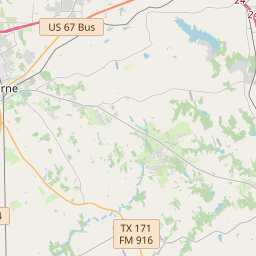Greenbrier Baptist Church







Constituted in 1878 with 17 charter members, this pioneer church originally served early settlers of the Greenbrier community, renamed Greenfield in 1917 when the Stubblefield School merged with the local district. Before the construction of sanctuaries, the Baptist and Methodist congregations met together in the community's schoolhouse. A center of activity in the surrounding area for over a century, the Greenbrier Baptist Church has been led by many prominent pastors and Johnson County pioneers
As one of the most visible programs of the Texas Historical Commission (THC), historical markers commemorate diverse topics in Texas history, including: the history and architecture of houses, commercial and public buildings, religious congregations, and military sites; events that changed the course of local and state history; and individuals who have made lasting contributions to the state, community organizations, and businesses.
In the late 19th century, Texas became known for its cattle drives, in which cowboys would move herds of cattle from Texas to railheads in Kansas and other northern states. The cattle drives were dangerous and difficult work, but they played a key role in the development of the American cattle industry.
The establishment of Johnson County can be traced back to 1854 when it was officially organized and named after Middleton Tate Johnson, a Texas Ranger and a Confederate commander during the Civil War. The county quickly began to grow, attracting settlers from nearby areas due to its abundant natural resources and favorable climate for agriculture. Cotton and corn became the primary crops, and the county's economy thrived, aided by the construction of railroads in the late 1800s.
Throughout its history, Johnson County has faced both triumphs and challenges. In the late 1800s, the county was known for its fertile soil and large cotton plantations, which contributed to its economic prosperity. However, like many areas in the South, Johnson County also experienced the hardships of Reconstruction following the Civil War. Additionally, the destructive effects of the Great Depression in the 1930s had a significant impact on the local economy, causing widespread poverty and unemployment.
In recent decades, Johnson County has seen significant growth and development. With an expanding population and a diverse economy, the county has become a hub for industry, commerce, and residential communities. Today, it continues to embrace its rich cultural heritage while adapting to the changing needs of its residents. Johnson County's historical legacy serves as a reminder of the resilience and determination of its people, allowing the county to thrive and face the future with confidence.
Johnson County Timeline
This timeline provides a condensed summary of the historical journey of Johnson County, Texas.
- 1846: Johnson County is established as a county in the state of Texas.
- 1861-1865: Johnson County sends soldiers to fight in the American Civil War.
- 1867: The county experiences economic growth as the Chisholm Trail passes through, bringing cattle drives and trade.
- 1879: The town of Cleburne is established as the county seat.
- 1880s: The arrival of the railroad boosts the local economy and facilitates transportation.
- 1893: The Johnson County Courthouse is constructed in Cleburne, becoming a local landmark.
- 1920s: The county suffers from the Great Depression, causing economic hardships for its residents.
- 1940s: Johnson County contributes to the war effort during World War II, with many residents serving in the military.
- 1950s-1960s: The county experiences population growth and suburbanization.
- 1990s: The opening of the Chisholm Trail Parkway provides improved transportation and connectivity.